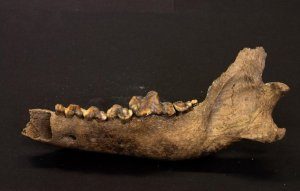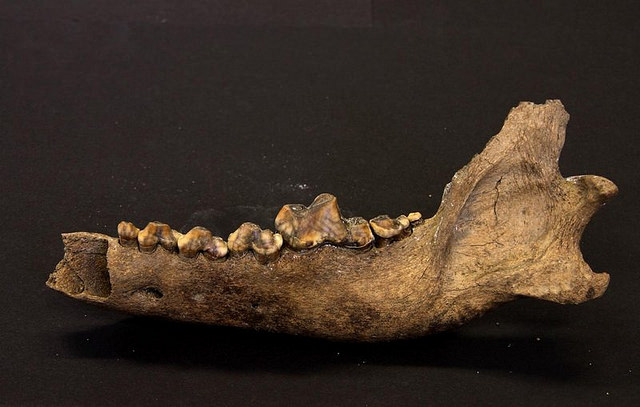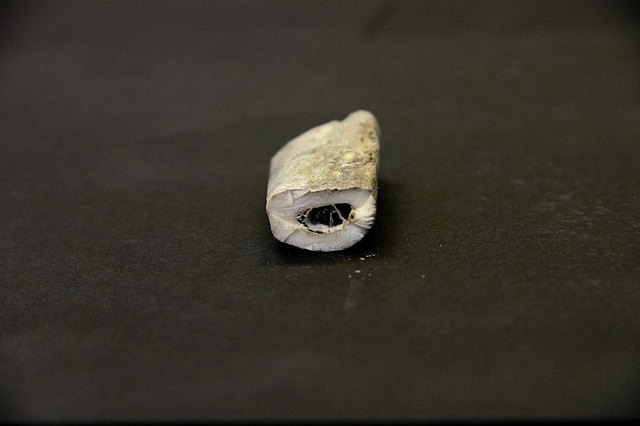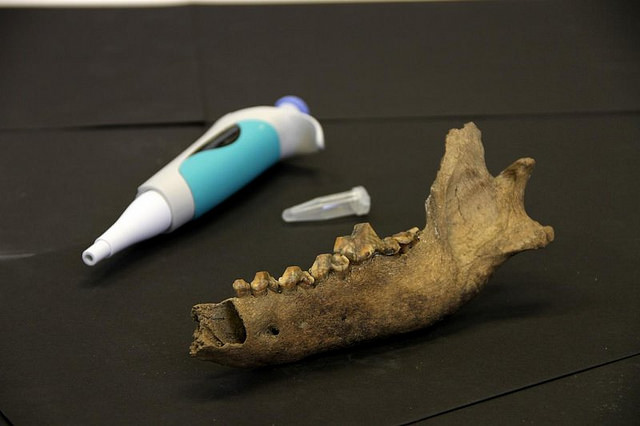
Cell Press—Dogs’ special relationship to humans may go back 27,000 to 40,000 years, according to genomic analysis of an ancient Taimyr wolf bone reported in the Cell Press journal Current Biology on May 21. Earlier genome-based estimates have suggested that the ancestors of modern-day dogs diverged from wolves no more than 16,000 years ago, after the last Ice Age.
The genome from this ancient specimen, which has been radiocarbon dated to 35,000 years ago, reveals that the Taimyr wolf represents the most recent common ancestor of modern wolves and dogs.
“Dogs may have been domesticated much earlier than is generally believed,” says Love Dalén of the Swedish Museum of Natural History. “The only other explanation is that there was a major divergence between two wolf populations at that time, and one of these populations subsequently gave rise to all modern wolves.” Dalén considers this second explanation less likely, since it would require that the second wolf population subsequently became extinct in the wild.
“It is [still] possible that a population of wolves remained relatively untamed but tracked human groups to a large degree, for a long time,” adds first author of the study Pontus Skoglund of Harvard Medical School and the Broad Institute.
The researchers made these discoveries based on a small piece of bone picked up during an expedition to the Taimyr Peninsula in Siberia. Initially, they didn’t realize the bone fragment came from a wolf at all; this was only determined using a genetic test back in the laboratory. But wolves are common on the Taimyr Peninsula, and the bone could have easily belonged to a modern-day wolf. On a hunch, the researchers decided to radiocarbon date the bone anyway. It was only then that they realized what they had: a 35,000-year-old bone from an ancient Taimyr wolf.
______________________________________
Above: Comparison of an ancient Taimyr wolf bone from the lower jaw to a modern pipette. Courtesy Love Dalén
______________________________________
 Above: Detailed view of an ancient Taimyr wolf bone from the lower jaw. The animal lived approximately 27,000 to 40,000 years ago. Courtesy Love Dalén
Above: Detailed view of an ancient Taimyr wolf bone from the lower jaw. The animal lived approximately 27,000 to 40,000 years ago. Courtesy Love Dalén
______________________________________
 Above: DNA from this small piece of a rib bone from an ancient Taimyr wolf suggests that dogs may have been domesticated at least 27,000 years ago. Courtesy Love Dalén
Above: DNA from this small piece of a rib bone from an ancient Taimyr wolf suggests that dogs may have been domesticated at least 27,000 years ago. Courtesy Love Dalén
______________________________________
The DNA evidence also shows that modern-day Siberian Huskies and Greenland sled dogs share an unusually large number of genes with the ancient Taimyr wolf.
“The power of DNA can provide direct evidence that a Siberian Husky you see walking down the street shares ancestry with a wolf that roamed Northern Siberia 35,000 years ago,” Skoglund says. To put that in perspective, “this wolf lived just a few thousand years after Neandertals disappeared from Europe and modern humans started populating Europe and Asia.”
______________________________________
A Cell Press press release.
______________________________________
 Did you like this? Read more articles like this with a premium subscription to Popular Archaeology Magazine.
Did you like this? Read more articles like this with a premium subscription to Popular Archaeology Magazine.
In addition, the latest Popular Archaeology ebook is now available.
______________________________________________
Travel and learn with Far Horizons.
____________________________________________
 Popular Archaeology’s annual Discovery Edition eBook is a selection of the best stories published in Popular Archaeology Magazine in past issues, with an emphasis on some of the most significant, groundbreaking, or fascinating discoveries in the fields of archaeology and paleoanthropology and related fields. At least some of the articles have been updated or revised specifically for the Discovery edition. We can confidently say that there is no other single issue of an archaeology-related magazine, paper print or online, that contains as much major feature article content as this one. The latest issue, volume 2, has just been released. Go to the Discovery edition page for more information.
Popular Archaeology’s annual Discovery Edition eBook is a selection of the best stories published in Popular Archaeology Magazine in past issues, with an emphasis on some of the most significant, groundbreaking, or fascinating discoveries in the fields of archaeology and paleoanthropology and related fields. At least some of the articles have been updated or revised specifically for the Discovery edition. We can confidently say that there is no other single issue of an archaeology-related magazine, paper print or online, that contains as much major feature article content as this one. The latest issue, volume 2, has just been released. Go to the Discovery edition page for more information.
____________________________________________








